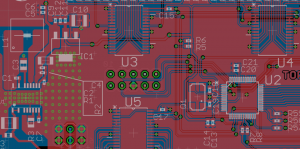Best Practices for Thermal Management in RF PCBs
Thermal Management in RF PCBs
RF PCBs must disperse heat efficiently while supporting high-speed signal transmission and maintaining precise impedance control. However, the complex nature of rf pcb applications makes it challenging to optimize performance and reliability. Fortunately, PCB engineers can leverage best practices in a number of critical areas such as impedance matching, signal routing optimization, and material selection to minimize performance issues such as overheating.
A common cause of overheating in RF circuits is poor design choices and components that aren’t rated for high temperatures. This can lead to premature component failure, which will require a costly redesign. It’s important to use the right PCB materials and to carefully select the correct dielectric constant for your application. This will ensure that your high-frequency signals can be transmitted with minimal signal reflections and attenuations, ensuring that you can achieve the desired performance outcomes for your specific application.
It can also be used to perform EMI/EMC analysis, which is important for ensuring that a circuit is free from noise and unwanted emissions. This is achieved by performing a radiated EMI/EMC analysis that helps to identify any sources of unwanted interference, and by comparing the simulated results to regulatory standards.
In addition to using the proper PCB materials, it’s essential to consider how components are positioned on the board and their spacing. Keeping high-power devices close together can create localized hotspots that will increase the temperature of nearby devices. To avoid this, you should try to spread high-power devices evenly across the board so that they’re not in direct contact with each other.

Best Practices for Thermal Management in RF PCBs
Another crucial area to focus on is the PCB’s metallurgy. In many cases, the PCB’s copper traces are responsible for most of its thermal conductivity, so it’s important to use thick copper traces that have a large surface area that will help to distribute and disperse heat effectively. Moreover, if you’re working with a thinner laminate, it may be helpful to use copper with a smooth surface to reduce insertion loss and improve heat flow efficiency.
To further enhance your thermal management strategy, it’s also worth considering the use of cooling fans. Cooling fans add a stream of cold air into your device, which helps to quickly disperse excess heat and prevent it from building up in critical areas.
The use of a heat pipe is also a good option. These pipes are a type of passive heat transfer system that maintains a consistent temperature within the device by transferring heat through the conductive metal. They’re also very quiet and don’t have any moving parts, making them an excellent choice for sensitive applications where noise or vibration is a concern.
Finally, it’s important to note that PCBs expand and contract when the ambient temperature changes. It’s therefore important to choose a PCB material with a low coefficient of thermal expansion (CTE) to mitigate the effect on mechanical stress caused by fluctuations in temperature.